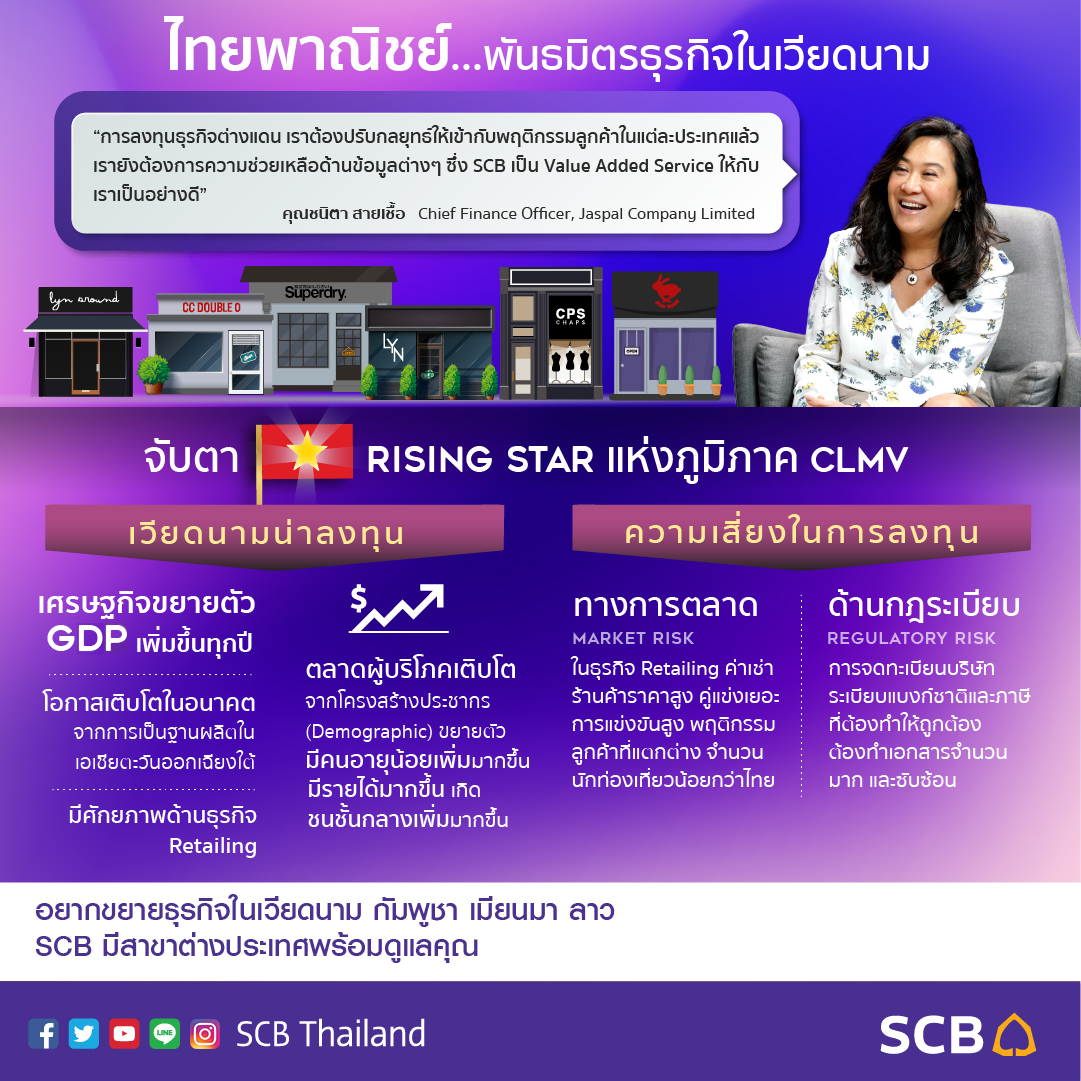I WANT
RELATED LINKS
I WANT
RELATED LINKS
RELATES LINKS
I WANT
RELATES LINKS
Services
Related Links
Use and Management of Cookies
We use cookies and other similar technologies on our website to enhance your browsing experience. For more information, please visit our Cookies Notice.
- Personal Banking
- Stories & Tips
- BUSINESS MAKER
- Vietnam…The Rising Star of CLMV
- Personal Banking
- ...
- Vietnam…The Rising Star of CLMV
Vietnam…The Rising Star of CLMV
06-02-2021
The change of economic landscape and world trade power have driven “Vietnam” to be one of the eye-catching markets for investors. Jaspal Company Limited, the leader in fashion retailing business, is a Thai company that has expanded its business in Vietnam. Khun Chanida Saichua, Jaspal’s Chief Finance Officer, shared us about an opening of Jaspal branch and affiliates including its growth potential in Vietnam.

The beginning of business expansion & Vietnam appealing market
Khun Chanida talked about an opening of “LYN”, the fashion and clothing store in Ho Chi Minh City, Vietnam under the “JPS Fashion (Vietnam)” company in 2017. It was started when Jaspal found that LYN leather bags have been popular among Vietnamese customers. Jaspal then decided to expand its business by launching LYN as the first brand in Vietnam, following by Superdry, Jelly Bunny, and CCOO. All those brands are now available in more than 20 stand-alone stores located on high streets and Department Stores in Ho Chi Minh and Hanoi. Sales were over 36 million USD in 2019.
“Vietnam’s retail market has a high potential for growth with some interesting factors, for example, an emerging market, a rising star of CLMV countries, the economic is booming as GDP increases continually every year, the consumer market is growing due to the rising of young people; on the contrary, Thailand is entering an aging society. Vietnamese tend to earn more income so raising the number of the middle class. Vietnam is a manufacturing-based country in Southeast Asia and has enticed more foreign investors so it has a tendency to grow in the long term”.
Additional to Vietnam, Jaspal invested in 4 Asian countries including Cambodia where there are 16 stores in Phnom Penh. LYN is strongly successful in Cambodia. The country is close to Thailand and is able to access Thai media that’s why Cambodian have known Thai brands so well and have also admired our quality products.
The difference between Vietnam and Thailand
To market the fashion retailing with 96 million Vietnamese, Jaspal needs to adjust its strategy because their customer behaviors differ from Thai people. Jaspal still keeps brand image but changes marketing campaign like Day promotion. Jaspal products are promoted by local influencer bloggers. “Vietnamese are familiar with LYN and the challenge is another brand like CCOO. The marketing team needs to create brand awareness by studying the market to build an advertising strategy for promoting CCOO products. As the brand awareness of LYN is quite good so local celebrities are used and online promotion is highly focused according to current marketing trend. For customer behavior, price quite matters to Vietnamese and they are price-sensitive comparing with Thai”, said Khun Chanida.
Apart from the offline channels, online marketing is second to none. Jaspal just introduced www.lynvn.com as an online product ordering and has used social media as a communication tool with customers. “Sales have to be more approachable for customers through Line or Facebook. The service is Chat & Shop and then to make a following-up call to them. Anyway, online marketing has limitations and gains well response in some product groups like LYN bags and shoes. Bags are easily sold online but online sales of clothing are not good enough, especially, fashionable wear in which the size of each collection varies. That’s why customers don’t prefer online shopping. Most people who buy clothes online tend to return them later”.
Adapt strategy to lessen the effects of COVID
During the outbreak of COVID early last year, branch stores in Vietnam temporarily closed regarding lockdown policy. The Bangkok office followed up the situation closely and reviewed a business plan to reduce all product manufacturing plans in Vietnam including products in the Thai market and other countries. Our immediate adaptation plan eventually helped lessen the effects of the COVID crisis.
What are the risks of running a business in Vietnam?
In general, the Vietnam market looks prosperous; undoubtedly there are risks in the business world. Khun Chanida divided risk into two parts comprising Market Risk such as store rent cost is higher than Thailand. For retailing, the rental fee in Vietnam is considered expensive comparing with an opportunity in generating sales. There are tons of competitors so the competition is high and it’s not easy to make a profit while the number of tourists is lower comparing with Thailand.
Another part is Regulatory Risk which includes regulations of company registration, national bank rules, and tax criteria, and other government concerned issues. All those practices must be legally conducted to protect the company from a bad reputation. “In summary, Regulatory Risk in Vietnam is extensive as Vietnam remains socialism country so there are plenty of documents to submit and the process is quite complex”. However, a commercial bank like SCB is located in Ho Chi Minh City to support and ensure a smooth opening of a new market. Khun Chanida summarized that “We don’t only need a financial loan for investing overseas but we also want the bank to provide us with insightful information about the market and regulations. And, SCB in Vietnam has long been well-known in the Vietnam market which we consider very important. Every bank offers the same financial service but we select the bank that is expertise in a particular market because it’s a value-added service given to us”. Customers who are interested in running a business in CLMV or Great Mekong Subregion: GMS, comprising Cambodia, Laos, Myanmar, and Vietnam, SCB is pleased to serve you at several overseas branches.

